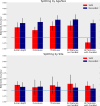This is a preprint.
Classification of Major Depressive Disorder Using Vertex-Wise Brain Sulcal Depth, Curvature, and Thickness with a Deep and a Shallow Learning Model
- PMID: 39975425
- PMCID: PMC11838705
Classification of Major Depressive Disorder Using Vertex-Wise Brain Sulcal Depth, Curvature, and Thickness with a Deep and a Shallow Learning Model
Update in
-
Classification of major depressive disorder using vertex-wise brain sulcal depth, curvature, and thickness with a deep and a shallow learning model.Mol Psychiatry. 2025 Oct 3. doi: 10.1038/s41380-025-03273-w. Online ahead of print. Mol Psychiatry. 2025. PMID: 41044403
Abstract
Major depressive disorder (MDD) is a complex psychiatric disorder that affects the lives of hundreds of millions of individuals around the globe. Even today, researchers debate if morphological alterations in the brain are linked to MDD, likely due to the heterogeneity of this disorder. The application of deep learning tools to neuroimaging data, capable of capturing complex non-linear patterns, has the potential to provide diagnostic and predictive biomarkers for MDD. However, previous attempts to demarcate MDD patients and healthy controls (HC) based on segmented cortical features via linear machine learning approaches have reported low accuracies. In this study, we used globally representative data from the ENIGMA-MDD working group containing 7,012 participants from 30 sites (N=2,772 MDD and N=4,240 HC), which allows a comprehensive analysis with generalizable results. Based on the hypothesis that integration of vertex-wise cortical features can improve classification performance, we evaluated the classification of a DenseNet and a Support Vector Machine (SVM), with the expectation that the former would outperform the latter. As we analyzed a multi-site sample, we additionally applied the ComBat harmonization tool to remove potential nuisance effects of site. We found that both classifiers exhibited close to chance performance (balanced accuracy DenseNet: 51%; SVM: 53%), when estimated on unseen sites. Slightly higher classification performance (balanced accuracy DenseNet: 58%; SVM: 55%) was found when the cross-validation folds contained subjects from all sites, indicating site effect. In conclusion, the integration of vertex-wise morphometric features and the use of the non-linear classifier did not lead to the differentiability between MDD and HC. Our results support the notion that MDD classification on this combination of features and classifiers is unfeasible. Future studies are needed to determine whether more sophisticated integration of information from other MRI modalities such as fMRI and DWI will lead to a higher performance in this diagnostic task.
Figures


References
-
- Ayyash S., Davis A.D., Alders G.L., MacQueen G., Strother S.C., Hassel S., Zamyadi M., Arnott S.R., Harris J.K., Lam R.W., Milev R., Müller D.J., Kennedy S.H., Rotzinger S., Frey B.N., Minuzzi L., Hall G.B., Team C.-B.I., 2021. Exploring brain connectivity changes in major depressive disorder using functional-structural data fusion: A CAN-BIND-1 study. Hum. Brain Mapp. 42, 4940–4957. 10.1002/hbm.25590 - DOI - PMC - PubMed
-
- Bayer J.M.M., Thompson P.M., Ching C.R.K., Liu M., Chen A., Panzenhagen A.C., Jahanshad N., Marquand A., Schmaal L., Sämann P.G., 2022. Site effects how-to and when: An overview of retrospective techniques to accommodate site effects in multi-site neuroimaging analyses. Front. Neurol. 13. - PMC - PubMed
-
- Belov V., Erwin-Grabner T., Gonul A.S., Amod A.R., Ojha A., Aleman A., Dols A., Scharntee A., Uyar-Demir A., Harrison B.J., Irungu B.M., Besteher B., Klimes-Dougan B., Penninx B.W.J.H., Mueller B.A., Zarate C., Davey C.G., Ching C.R.K., Connolly C.G., Fu C.H.Y., Stein D.J., Dima D., Linden D.E.J., Mehler D.M.A., Pomarol-Clotet E., Pozzi E., Melloni E., Benedetti F., MacMaster F.P., Grabe H.J., Völzke H., Gotlib I.H., Soares J.C., Evans J.W., Sim K., Wittfeld K., Cullen K., Reneman L., Oudega M.L., Wright M.J., Portella M.J., Sacchet M.D., Li M., Aghajani M., Wu M.-J., Jaworska N., Jahanshad N., van der Wee N.J.A., Groenewold N., Hamilton P.J., Saemann P., Bülow R., Poletti S., Whittle S., Thomopoulos S.I., Van S.J.A., Werff D., Koopowitz S.-M., Lancaster T., Ho T.C., Yang T.T., Basgoze Z., Veltman D.J., Schmaal L., Thompson P.M., Goya-Maldonado R., 2022. Multi-site benchmark classification of major depressive disorder using machine learning on cortical and subcortical measures. - PMC - PubMed
-
- Caruana R., 1997. Multitask Learning. Mach. Learn. 28, 41–75. 10.1023/A:1007379606734 - DOI
Publication types
Grants and funding
- R37 MH101495/MH/NIMH NIH HHS/United States
- P41 RR008079/RR/NCRR NIH HHS/United States
- UL1 TR001872/TR/NCATS NIH HHS/United States
- R33 AT009864/AT/NCCIH NIH HHS/United States
- R01 MH116147/MH/NIMH NIH HHS/United States
- R01 HD050735/HD/NICHD NIH HHS/United States
- R01 CA193522/CA/NCI NIH HHS/United States
- K23 MH090421/MH/NIMH NIH HHS/United States
- R61 AT009864/AT/NCCIH NIH HHS/United States
- ZIA MH002857/ImNIH/Intramural NIH HHS/United States
- P30 CA016672/CA/NCI NIH HHS/United States
- U54 EB020403/EB/NIBIB NIH HHS/United States
- R01 MH117601/MH/NIMH NIH HHS/United States
- K01 MH117442/MH/NIMH NIH HHS/United States
- R01 NS073939/NS/NINDS NIH HHS/United States
- R01 MH085734/MH/NIMH NIH HHS/United States
- R21 AT009173/AT/NCCIH NIH HHS/United States
- R01 MH125850/MH/NIMH NIH HHS/United States
LinkOut - more resources
Full Text Sources
Research Materials
Miscellaneous
